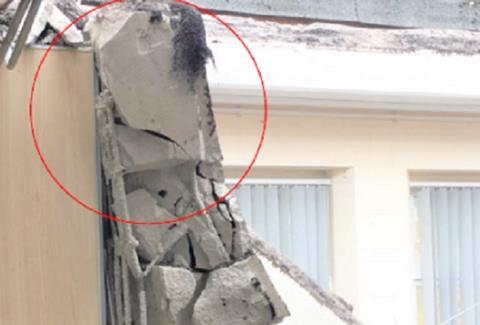Consultants say use of dangerous lightweight concrete panels was widespread in social housing in the ‘50s-’70s
Calls are growing for social housing landlords to embark on urgent programme of inspections in order to establish the prevalence of a potentially dangerous form of lightweight concrete that has already forced the closure of 156 schools.
Consultants have told ∫√…´œ»…˙TV‚Äôs sister title Housing Today that the use of panels made from Reinforced Autoclaved Aerated Concrete, better known as RAAC, was widespread across public sector building from the 1950s to the 1970s, affecting social housing as well as school construction.

∫√…´œ»…˙TV surveyor Rapleys said work it has done surveying the public estate as a whole suggested that as many as one in 10 public buildings from the period contained RAAC panels.
Law firm Winckworth Sherwood said housing associations should “urgently check” building specifications and drawings for the use of RAAC, and commission “immediate structural surveys” where it is found.
Greg Carter, legal director and construction specialist at the firm, said: “RAAC was widely used in the construction of social housing between the 1950s and 1990s and, just as in school buildings and other structures, presents a serious risk for housing associations and their residents.
“No nationwide survey of social housing has been conducted and the extent of the problem is unknown. Thorough checks of housing stock will be the only way to fully understand the size and scale of any problems.”
Carter said landlords may be able to claim the cost of remedial works on building or other insurance policies, however, these may be subject to 30-year limit. Either way, he said: “Inaction is not an option.”
>> See also
>> See also
Richard Crow, partner in housing consultancy and head of Birmingham office at Rapleys, urged landlords to inspect properties containing flat roofs, built during the 1950s, 60s and 70s.
He said the extent of the problem depended on how many properties were built during the 50s, 60s and 70s, because the manufacture and design of the panels during this period was “inefficient and inadequate, with steel reinforcement also installed in the wrong place”.
He added: “It will be a case of urgent thorough inspection across the country by local authorities, and then for those that do have it, putting in place the solutions to ensure they are protected against damage.”
Crow added that while RAAC had in more recent decades been manufactured more successfully and become an appropriate construction method, the problems associated with its use in earlier years were compounded by a lack of Planned Maintenance Programmes or appropriate technically qualified persons to inspect the buildings.
He added that he had experienced RAAC having been used on single storey dwellings, so landlords shouldn’t assume that this material was only used on high rise buildings. “In practice, these panels were cheap to procure, easy to install and widely used by any construction contractor of the time, with no mechanism to monitor or record where they were installed,” Crow said.
The risks posed by RAAC panels have been highlighted by a number of reports including the Standing Committee on Structural Safety report, from May 2019, the Safety Briefing Notice produced by the Office of Government Property in September 2022, and The Institution of Structural Engineers, which issued guidance in February 2022.
Last week the Department for Education closed 156 schools at a week’s notice after a beam collapsed in a RAAC-built school over the summer, which appears to have changed the department’s calculation of the risks associated with the panels.
The Department for Levelling Up, Housing and Communities has been contacted for comment.

























No comments yet